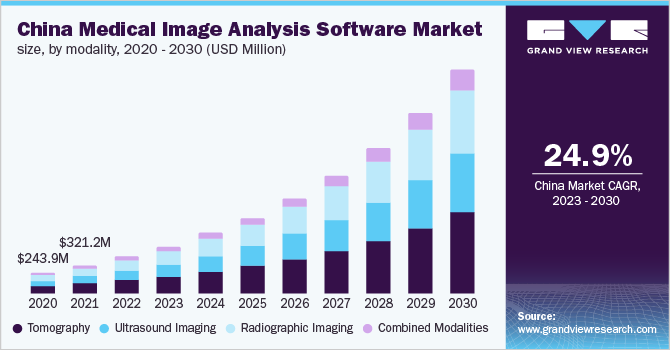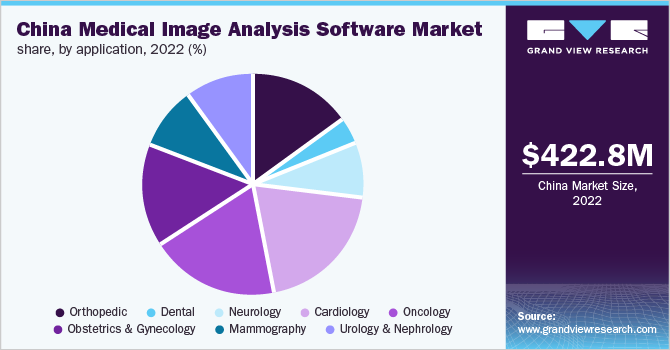- Home
- »
- Healthcare IT
- »
-
China Medical Image Analysis Software Market Report, 2030GVR Report cover
![China Medical Image Report]()
China Medical Image Analysis Software Market Size, Share & Trends Analysis Report By Software Type (Integrated Software, Standalone Software), By Imaging Type, By Modality, By Application, By End-use, And Segment Forecasts, 2023 - 2030
- Report ID: GVR-4-68040-029-6
- Number of Report Pages: 150
- Format: PDF, Horizon Databook
- Historical Range: 2018 - 2021
- Forecast Period: 2023 - 2030
- Industry: Healthcare
Report Overview
The China medical image analysis software market size was valued at USD 422.8 million in 2022 and is expected to expand at a compound annual growth rate (CAGR) of 24.9% from 2023 to 2030. The primary growth drivers for this market include favorable government policies, the requirement for precise diagnosis & automation, growing demand for remote consultation, and advancements in medical imaging technology.

For instance, in recent years, the demand for online medical consultation and diagnosis has continuously increased, indicating a growing patient population in need of services provided by imaging cloud platforms. Patients can exchange medical images with experts via the cloud platform to conduct remote diagnoses, with experts subsequently doing AI-aided diagnoses on those images and providing digital reports or prescriptions to patients. As a result, this demonstrates the growing importance of digital images and cloud servers as the key technology required for AI-aided detection of lesion locations and online consultation.
Furthermore, in China, novel technologies are being used to combat the COVID-19 outbreak, positively supporting market growth. These technologies are based on AI algorithms, and analytics software, and also make use of drones to ensure efficient & timely hospital deliveries. Thus, the pandemic accelerated advancements in AI systems by including the potential to utilize these techniques. AI and radionics were used in conjunction with CT scans and X-rays as advanced imaging technologies in the detection as well as follow-up of COVID-19. For example, Zhongnan Hospital in China used AI to read CT scans and determine COVID-19 symptoms.
Additionally, companies utilized the COVID-19 pandemic as a point of challenge and introduced a wide range of products that would aid users throughout the pandemic, ultimately resulting in revenue growth for the company. For instance, in China in February 2020, AI-based company Infervision launched a coronavirus AI-powered system intended for frontline usage to help physicians efficiently diagnose and manage the condition. The Tongji Hospital in Wuhan, China, as well as other facilities such as the Third People's Hospital in Shenzhen, have all made use of the software.
The emerging AI technologies in the existing medical image system are indicative of high growth potential in the market. Innovation and integration of AI show potential opportunities for payers to meet healthcare demands with existing infrastructure. For instance, in 2019, Siemens Healthineers introduced SOMATOM go.Top, a 128-slice CT system. With a scanning speed of 0.33 seconds per revolution, it is built with integrated AI technology and is intended for rapid scans & related analysis. At the 31st International Medical Instruments and Equipment Exhibition, held in China, the company also unveiled the Biograph mMR PET/MRI system. Because of the system’s noise reduction software, it can produce clear images even when the patient is moving during the scan.
Software Type Insights
Based on software type, the medical image analysis market in China is divided into integrated software and stand-alone software. Medical image analysis is crucial in medical technology. Incorporating innovative technologies into the image processing and analysis pipeline can assist the healthcare sector in addressing data-related challenges. Thus, it has created significant opportunities in China’s medical image analysis software market. The integrated software segment held the highest market share of over 65% in 2022, owing to the increased adoption of diagnostic imaging and several advantages of integrated software such as centralized data storage and cost-effectiveness.
Modality Insights
The tomography segment held the highest share of the total revenue of over 35% in 2022 due to its cost-effectiveness. This is primarily due to the large size of the China market, which offers a significant variable for the absorption of image data in addition to sufficient volume and diverse data sources.
The images for medical image analysis can also be obtained from medical imaging modalities such as tomography, ultrasound imaging, radiographic imaging, and combined modalities. Tomography is further subdivided into Computed Tomography (CT), Magnetic Resonance Imaging (MRI), Positron Emission Tomography (PET), and Single-Photon Emission Computed Tomography (SPECT).
Imaging Type Insights
Based on imaging type, China’s medical image analysis software market is divided into 2D imaging, 3D imaging, and 4D imaging. 3D medical imaging is the leading segment among other imaging types in China medical image analysis software market. Several companies are introducing advanced imaging systems in China, which is expected to boost the demand for 3D imaging. For instance, in 2021, Huawei introduced a new medical imaging system that converts 2D images to 3D in China.
For instance, in recent years, the demand for online medical consultation and diagnosis has continuously increased, indicating a growing patient population in need of services provided by imaging cloud platforms. Patients can exchange medical images with experts via the cloud platform to conduct remote diagnoses, with experts subsequently doing AI-aided diagnoses on those images and providing digital reports or prescriptions to patients. As a result, this demonstrates the growing importance of digital images and cloud servers as the key technology required for AI-aided detection of lesion locations and online consultation.
End-use Insights
Based on end-use, the China medical image analysis software market is divided into hospitals, diagnostic centers, and others. The hospital segment held the largest market share in terms of revenue of over 35% in 2022. The rise in the incidence of diseases and disorders has led to an increase in the number of patients visiting physicians in hospitals. Furthermore, increased financing capabilities and a higher number of surgeries are expected to drive the growth of the segment.
Application Insights
The cardiology segment holds a notable share of 20% in 2022, owing to the rising prevalence of cardiovascular & congenital heart diseases and rising government support to improve treatment accessibility.

Based on application, the segment is further divided into orthopedic, cardiology, neurology, oncology, dental, obstetrics & gynecology, mammography, and urology & nephrology. Due to the higher incidence and mortality of heart disease in China's large population, the use of cardiovascular imaging for condition assessment has increased in recent years.
Key Companies & Market Share Insights
The market is highly fragmented and is dominated by various companies accounting for a considerable share of the market. Philips, Agfa Healthcare, and Siemens are the major players in this sector, and all offer similar products and services, resulting in a highly competitive environment. They are implementing extensive growth strategies, such as entering into strategic alliances, increasing product differentiation, and mergers & acquisitions, to gain a larger market share.
For instance, in November 2021, Siemens Healthineers collaborated with Subtle Medical to incorporate Subtle Medical's SubtleMR image-enhancement software into its MRI machines. Subtle Medical is a provider of AI-driven solutions for medical imaging. Some prominent players in the China medical image analysis software market include:
-
Koninklijke Philips N.V.
-
Agfa-Gevaert Group
-
Canon Medical Systems
-
MIM Software Beijing Co., Ltd.
-
Bruker
-
Siemens Healthineers AG
-
ESAOTE SPA
-
Deepwise
-
Neusoft Medical Systems Co., Ltd.
-
Infervision Medical Technology Co., Ltd.
China Medical Image Analysis Software Market Report Scope
Report Attribute
Details
The market size value in 2023
USD 534.2 million
Revenue forecast in 2030
USD 2.53 billion
Growth Rate
CAGR of 24.9% from 2023 to 2030
Base year for estimation
2022
Actual estimates/Historical data
2018 - 2021
Forecast period
2023 - 2030
Quantitative units
Revenue in USD Million & CAGR from 2023 to 2030
Report coverage
Revenue forecast, company share, competitive landscape, growth factors, and trends
Segments covered
Software type, modality, imaging type, application, end-use
Country Scope
China
Key companies profiled
Koninklijke Philips N.V.; Agfa-Gevaert Group; Canon Medical Systems; MIM Software Beijing Co., Ltd.; Bruker;Siemens Healthcare GmbH; ESAOTE SPA; Deepwise; Neusoft Medical Systems Co., Ltd.; Infervision Medical Technology.
Customization scope
Free report customization (equivalent up to 8 analysts’ working days) with purchase. Addition or alteration to country, regional & segment scope.
Pricing and purchase options
Avail customized purchase options to meet your exact research needs. Explore purchase options
China Medical Image Analysis Software Market Segmentation
This report forecasts revenue growth at the country level and provides an analysis of the latest industry trends in each of the sub-segments from 2018 to 2030. For this study, Grand View Research has segmented the China medical image analysis software market report based on software type, imaging type, modality, application, and end-use:
-
Software Type Outlook (Revenue, USD Million, 2018 - 2030)
-
Integrated Software
-
Standalone Software
-
-
Modality Outlook (Revenue, USD Million, 2018 - 2030)
-
Tomography
-
Computed Tomography
-
Magnetic Resonance Imaging
-
Positron Emission Tomography
-
Single-Photon Emission Tomography
-
Ultrasound Imaging
-
-
Radiographic Imaging
-
Combined Modalities
-
-
Imaging Type Outlook (Revenue, USD Million, 2018 - 2030)
-
2D Imaging
-
3D Imaging
-
4D Imaging
-
-
Application Outlook (Revenue, USD Million, 2018 - 2030)
-
Orthopedic
-
Dental
-
Neurology
-
Cardiology
-
Oncology
-
Obstetrics & Gynecology
-
Mammography
-
Urology & Nephrology
-
-
End-use Outlook (Revenue, USD Million, 2018 - 2030)
-
Hospitals
-
Diagnostic Centers
-
Others
-
Frequently Asked Questions About This Report
b. The China Medical Image Analysis Software market size was estimated at USD 422.80 million in 2022 and is expected to reach USD 534.18 million in 2023.
b. The China Medical Image Analysis Software market is expected to grow at a compound annual growth rate of 24.9% from 2023 to 2030 to reach USD 2.53 billion by 2030.
b. The integrated software segment dominated the China Medical Image Analysis Software market with a revenue market share of over 65% in 2022. This is attributable to the increased adoption of diagnostic imaging and several advantages of integrated software such as centralized data storage and cost-effectiveness.
b. Some key players operating in the China Medical Image Analysis Software market include Koninklijke Philips N.V.; Agfa-Gevaert Group; Canon Medical Systems; MIM Software Beijing Co., Ltd.; Bruker; Siemens Healthineers AG; ESAOTE SPA; Deepwise; Neusoft Medical Systems Co., Ltd; and Infervision Medical Technology Co., Ltd.
b. Key factors that are driving the market growth include favorable government policies, the requirement for precise diagnosis and automation, the demand for remote consultation, and the advancements in medical imaging technology.
Share this report with your colleague or friend.
![gvr icn]()
NEED A CUSTOM REPORT?
We can customize every report - free of charge - including purchasing stand-alone sections or country-level reports, as well as offer affordable discounts for start-ups & universities. Contact us now
![Certified Icon]()
We are GDPR and CCPA compliant! Your transaction & personal information is safe and secure. For more details, please read our privacy policy.
We are committed towards customer satisfaction, and quality service.
"The quality of research they have done for us has been excellent."





